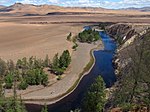This article lists the sites registered with World Heritage in Mongolia.
Understand
The Mongolia accepts the convention for the protection of the world cultural and natural heritage . The first protected site was inscribed in 2003.
The Mongolia has 4 sites registered with World Heritage, 3 cultural and 1 natural.
Listing
The following sites are listed as World Heritage.
| Site | Type | Criterion | Description | Drawing | |||||||||||||||||||||
|---|---|---|---|---|---|---|---|---|---|---|---|---|---|---|---|---|---|---|---|---|---|---|---|---|---|
| 1 Mongolian Altai Petroglyph Sets | Cultural | (iii) | Numerous petroglyphs and funerary monuments discovered at these three sites illustrate the development of culture in Mongolia over a period of some 12,000 years. The oldest images reflect a time (11,000 - 6,000 BC) when the area was partly forested and the valley provided habitat for big game hunters. The later representations correspond to the transition to pastoralism as the dominant way of life. The most recent representations show the transition to an equestrian nomadism during the 1st millennium BC. J.C., the Scythian period and the later Turkic period (7th-8th centuries AD). These petroglyphs make a valuable contribution to our understanding of the life of prehistoric communities in North Asia. |  | |||||||||||||||||||||
| 2 Orkhon Valley Cultural Landscape | Cultural | (ii), (iii), (iv) | The Orkhon Valley Cultural Landscape, approximately 121 967 Ha, covers a large area of pasture on both banks of the Orkhon and includes many archaeological remains dating back to the 6th century. The site also encompasses Karakorum, capital in the 13th and 14th centuries of the vast empire of Chingis (Genghis) Khan. The remains of the site reflect the symbiotic links between nomadic pastoral societies and their administrative and religious centers, and the importance of the Orkhon Valley in the history of Central Asia. The grasslands are still used today by nomadic herders in Mongolia. |  | |||||||||||||||||||||
| 3 Ubs Nuur Basin site shared with the Russia | Natural | (ix), (x) | The Ubs Nuur Basin, which covers an area of more than one million hectares, is the northernmost closed basin in Central Asia. It takes its name from the Ubs Nuur, a large, shallow and very salty lake, which plays an important role in the life of migratory birds, both aquatic and marine. The site, divided into twelve protected areas, includes a wide range of ecosystems that represent the main biomes of eastern Eurasia. The steppe ecosystem supports a rich diversity of birds and the desert a number of rare gerbils, jerboas and marbled polecats. The mountains are important refuges for the snow leopard (an endangered species), argali and Asian ibex. |  | |||||||||||||||||||||
| 4 Great Burkhan Khaldun Mountain and its surrounding sacred landscape | Cultural | (iv), (vi) | The Burkhan khaldun is considered the most sacred mountain in Mongolia, having been officially declared sacred by Genghis Khan himself, although it is shown that the mountain already had great religious significance long before Genghis Khan gave it importance. that she has today. |  | |||||||||||||||||||||
Criteria legend
| |||||||||||||||||||||||||
